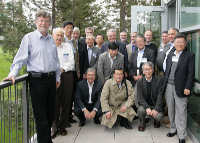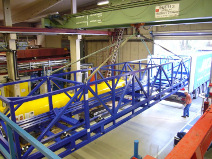From SLAC Today: ICFA Sharpens Focus on the Energy Frontier

ICFA Chair Albrecht Wagner (left) and ICFA members.
(Photo: Calla Cofield) |
“Particle physics is at a crossroads,” said Chairperson Albrecht Wagner of the International Committee for Future Accelerators, in the opening moments of the ninth ICFA Seminar last Tuesday in Kavli Auditorium. “The Standard Model stands triumphant,” Wagner said, “yet incomplete.”
Read more...
|
|
 |
 |
|
|
 |
FLASH under ILC charge — almost
Machine experts try to run DESY's free-electron laser under ILC-like conditions

To send a high-charge beam through FLASH, the 9-mA study team took charge of DESY's accelerator control room. |
More than 1034 times per second per square centimetre — that’s how often electrons and positrons are supposed to collide in the ILC. The project’s accelerator experts have no doubts that it can be done, but they have to demonstrate it, too. An important proof is to run ILC-like beam conditions through a radiofrequency (RF) unit that consists of one klystron and 26 superconducting cavities housed in three cryomodules. Running ILC-like beam conditions means running the cavities at their gradient limits and with 800-microsecond beam pulses with an average current of about nine milliamperes (or mA). The FLASH accelerator at DESY is capable of approaching these ILC-like beam conditions, but they are at the design limits of the machine and are well beyond typical operating conditions. An international team with members from DESY, FNAL, SLAC, KEK, and Argonne have come together for a series of tests that wants to drive an ILC-like beam through FLASH.
Read more...
-- Barbara Warmbein |
 |
|
|
 |
From symmetry breaking
5 November 2008
Should a photon-photon collider precede the ILC?
Should the International Linear Collider (ILC) be the next big project for high energy physics? Or should a smaller, less expensive collider be the next step? Former director of Japan’s KEK laboratory and former International Committee on Future Accelerators chairperson Hirotaka Sugawara proposes that the HEP community build a photon-photon collider prior to building the ILC. When asked “Why the rush?” he replied, “Why should we wait?”
Read more... |
|
From BBC
3 November 2008
Future of physics 'under threat'
...Professor Foster is also European director of the International Linear Collider, a giant machine that would follow on from the recently opened Large Hadron Collider at Cern.
Read more... |
|
From Women in Technology
3 November 2008
Global computer grid used by UK
...The project is being funded by the Science and Technology Facilities Council, whose director chief executive, Keith Mason, commented: "We actively encourage the researchers we fund to consider the wider applications of the work they do. "In this case, computing problems that had to be addressed for particle physics can also be used to solve other challenges with large amounts of data." A successor to the Large Hadron Collider, the International Linear Collider, is already in the planning stages of its development.
Read more... |
|
From Mainichi Shimbun
2 November 2008
超大型加速器:国際リニアコライダー計画、政府が日本誘致を検討
"超大型加速器「国際リニアコライダー計画」について、政府は31日、河村建夫官房長官を中心に文部科学省や経済産業省など関係省庁の局長級でチームを作り、日本誘致を検討することを決めた。"
Read more... |
|
From physicsworld.com
31 October 2008
Condensed-matter physicist to head DESY
...Dosch will see DESY take an important role in XFEL, the European X–ray Free Electron Laser, which is being built next to the lab’s Hamburg site. He will also oversee DESY’s ongoing contribution to the development of new technologies for the International Linear Collider — the next big particle physics experiment after the LHC.
Read more... |
|
|
 |
 |
|
|
 |
The first Project Advisory Committee review

Jean-Eudes Augustin, CNRS/IN2P3, chair of the PAC |
An integral part of process of carrying out a project is the review system. It takes a lot of effort (we commonly feel that is it too much effort) to prepare for, present and respond to review committees. However, the other side of that coin is that fresh eyes can stimulate hard and careful thinking on the part of those being reviewed, can sometimes anticipate problems and can even insert good new ideas. As we move forward in the Technical Design Phase, a new review process is being developed with two principle elements: a primarily “internal” review process for ongoing in-depth technical reviews and an “external” review process for accountability and high-level reviewing. Our external reviewers who report to the International Linear Collider Steering Committee (ILCSC), the Project Advisory Committee (PAC) chaired by Jean-Eudes Augustin, held their first meeting in Paris in early October and have now released their first report
Read more...
-- Barry Barish
Director's Corner Archive |
 |
|
|
 |
Acceleration by road

One day cryomodules are supposed to transport electron beams in the European XFEL and the ILC — two days ago, however, the first full cryomodule was itself transported from DESY in Germany to Saclay in France in an exercise to find out how the module moves during transport. A custom-made transport structure (blue) holds it in place on the truck. Experimenters at Saclay will now unload it to check the handling. After a few days it will be accelerated back to DESY.
|
EUROTeV Reports
2008-052
Placet Based Start-To-End simulations of the ILC with Intra-Train Fast Feedback System
2008-053
Layout and Simulations of the Font System at ATF2
|
|

